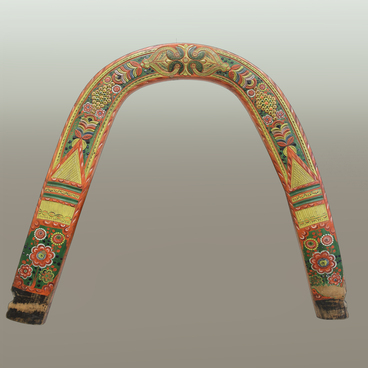The presented distaff is one of the most famous ones in the collection of folk art in the Russian Museum. It is decorated with the graphic from the arguably most ancient Severodvinsk center — Permogorye. The patterns and genre scenes on the front and back sides are traditional for this area. The peasant master Yakov Yarygin is claimed to have painted this unique exhibit.
Permogorye painting got its name from the pier on the Northern Dvina. The artisans from the surrounding villages made and painted distaffs and other wooden utensils: mugs, ladles, birch-bark boxes and others. This center of paintings on a white background was discovered in the middle of the 20th century by the expeditions that had been organized by large museums, including the Russian Museum. Some folk art specialists hold an opinion that that the Permogorye peasant Yakov Yarygin (one of the best masters of the first half — the middle of the 19th century) illustrated the events of his own life when decorating wooden utensils with paintings.
The genre scene on the front side, depicting a man with an accordion and a woman with a distaff, can be considered as a clear illustration of the spinning process, when the spinner puts the distaff on the bench, sits on the base and pulls a thread by twisting flax, wool or hemp that are attached to the comb.
Distaffs of a similar design were often made from a single solid tree with roots. It could be birch or spruce. Such distaffs were called root ones. There were also compound distaffs, the comb, leg and bottom of which were made separately, and then assembled into a single structure. Such distaffs were very common in Central Russia and in the regions of the Russian North. Distaffs with a hole in the bottom for inserting the comb were used in the Volga region.
A distaff was not only a tool, it was also a ritual object. It enhanced the beauty of the girl’s costume at gatherings where future family couples formed, and demonstrated the well-being of the family of the future bride. It was commissioned specifically from a well-known master in the area, and it was expensive. Sometimes men made distaffs on their own: a husband could make a distaff for his wife, a father — for his beloved daughter. Such gifts often featured dedicatory inscriptions.
Permogorye painting got its name from the pier on the Northern Dvina. The artisans from the surrounding villages made and painted distaffs and other wooden utensils: mugs, ladles, birch-bark boxes and others. This center of paintings on a white background was discovered in the middle of the 20th century by the expeditions that had been organized by large museums, including the Russian Museum. Some folk art specialists hold an opinion that that the Permogorye peasant Yakov Yarygin (one of the best masters of the first half — the middle of the 19th century) illustrated the events of his own life when decorating wooden utensils with paintings.
The genre scene on the front side, depicting a man with an accordion and a woman with a distaff, can be considered as a clear illustration of the spinning process, when the spinner puts the distaff on the bench, sits on the base and pulls a thread by twisting flax, wool or hemp that are attached to the comb.
Distaffs of a similar design were often made from a single solid tree with roots. It could be birch or spruce. Such distaffs were called root ones. There were also compound distaffs, the comb, leg and bottom of which were made separately, and then assembled into a single structure. Such distaffs were very common in Central Russia and in the regions of the Russian North. Distaffs with a hole in the bottom for inserting the comb were used in the Volga region.
A distaff was not only a tool, it was also a ritual object. It enhanced the beauty of the girl’s costume at gatherings where future family couples formed, and demonstrated the well-being of the family of the future bride. It was commissioned specifically from a well-known master in the area, and it was expensive. Sometimes men made distaffs on their own: a husband could make a distaff for his wife, a father — for his beloved daughter. Such gifts often featured dedicatory inscriptions.


